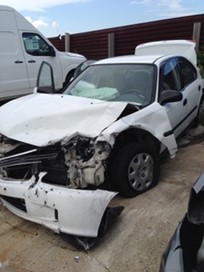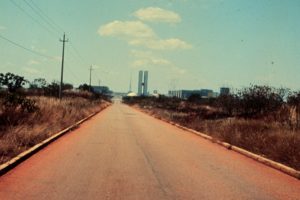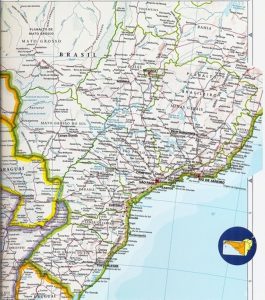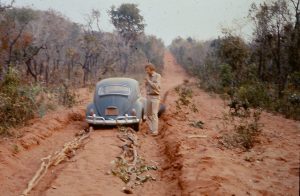31 Driving in Brazil
↑Driving in Brazil by Rick Bein
I think any driving culture has little to do with the ordinary etiquette of its society. When new technology is introduced, it seems to evolve its own cultural definition despite that of the traditional culture. Examples are radios, telephones, television, and the recent cell phone technology. The automobile has presented such challenges resulting in many new laws and regulations. When a motoring tradition begins it is difficult to change. Once behind the wheel of an automobile, the local driver shifts into the driving mode that has become established at that place.
My experience is that the Brazilian’s personality changes dramatically when he gets behind the wheel of the automobile. The Brazilians are the most charming, loving, and gregarious of all peoples, but that is not true when they drive. Each driver becomes a highly competitive individual determined to be “first.” All other vehicles on the road are the enemy, any one of which will cut him off and cross into his lane if they so much as become a fender ahead. Needless to say, driving is not a polite activity in Brazil.
Brazilians joke that obtaining a driver’s license only requires a good horn on the car and knowledge of the many gestures. Most of these gestures are not friendly ones. The “OK” sign used in the States as a positive indicator, has a totally different meaning in Brazil. The circle formed between the index finger and the thumb is a crude representation of the anus.
Brazilian automobile traffic is particularly crazy in the larger cities like Rio de Janeiro and São Paulo. There, driving is not for the timid. Only the most macho take to the streets where a timid driver never ventures. Waiting at the traffic light a driver will keep gunning his engine, flashing vulgar had signals at the next driver who is doing the same thing. When the traffic light changes, it is like the checkered flag has dropped and they are off to win the next 500 feet to the next traffic light! Avenida Sete de Setembro should be called Corrida Sete Setembro!

Example of a crashed car. Photo by Rick Bein 2016
The right-of-way in Brazilian traffic goes to the largest vehicle. If your cars are equal in size, then the less beat-up car yields to the more dilapidated. The more dilapidated has less to lose in a collision. The last in the pecking order in traffic is the pedestrian, who is not even safe on the sidewalk!
The “walk” sign for pedestrians at intersections shows a picture of a little man running to beat hell!
When crossing the street in Rio as a pedestrian, I recommend that the crossing never be done at the intersection of crosswalks. I find that much too dangerous as I must look in four different directions before taking my life into my own hands. It is safer to move half a block down one of the intersecting streets and then cross over (called jaywalking in the States), where I only have to look two directions. Most of the locals cross the streets in the same way. Many Brazilian young people do an artful job of dodging between moving cars in order to get to the other side. Typically, when parking along the street, someone will offer to watch your car for you while you are away. To this, you must say “yes” if you want your car to be the same when you return. Of course, a small tip is in order if your car is unscathed.
Are there speed limits in Brazil? Yes, and many of the same driving laws that there are in the States. Enforcing them is another story. The police drive fusquinos like mine and can never stop a speeding car. The solution is to write down the license plate numbers of the offending cars and enter them into a vehicle registry. The fines sit in the registry until that vehicle is sold. Then, the owner has no recourse, not knowing when or how the infraction occurred, and must now pony up. I found this out when it was time to sell the car.
The accident rate in Rio is one of the highest in the world. Auto insurance is so expensive that the annual charge is 1/3 the value of the vehicle. That means you pay for your car again in three years!
I bought a used Volkswagen Bug in Rio to drive to the interior of Brazil where I was to conduct my dissertation research. I was afraid to drive and kept it parked for several days until I was ready to leave. I thought it would be safer to leave in the early morning hours like 3 AM when most people would be sleeping and there would be fewer cars on the street. One part was true. There were fewer cars on the street, but it was no safer.
The few drivers on the streets made up for the others who were absent. Those few drove like maniacs speeding down blind alleys, zooming through cross streets making only the sign-of-the-cross to protect themselves. Traffic lights clearly are “yield signs,”, whose color makes no difference, as drivers tear through intersections at 80 miles per hour. Somehow, we made it out of Rio, but it took me several days to calm down. Now you know why the Brazilians compete well in the Indianapolis 500!
Once out of the city and on the road, things were a little more predictable, even though the reality of the speed limit was “how fast my car will go.” Being in an old Volkswagen bug, I had little to test and just kept out of the passing lane while cars sped by.
We decided to route through the new capital Brasília. The road there was four lanes and comfortable. Brasilia was under construction and the buildings were growing out of the “Campo Cerrado,” a dry season savanna vegetation, which today has mostly been taken over by soybean farming.

Tres Poderes rising out of the “Campo Cerrado” Brasilia. Photo by Rick Bein 1971.
↑ Southern Brazil: We drove to Campo Grande, Mato Grosso going west of Rio. Traffic was somewhat better in the interior of Brazil. We drove northwest to Brasilia and southwest to Campo Grande. Mapa América del Sur – América do Sul – South America map” by thejourney1972 (South America addicted) is licensed under CC BY 2.0
Southern Brazil: We drove to Campo Grande, Mato Grosso going west of Rio. Traffic was somewhat better in the interior of Brazil. We drove northwest to Brasilia and southwest to Campo Grande. Mapa América del Sur – América do Sul – South America map” by thejourney1972 (South America addicted) is licensed under CC BY 2.0
Leaving Brasilia, we headed southwest on a national road toward Campo Grande, Mato Grosso which was shown on the Brazilian National Highway map. I knew that no such road existed when I was in the Peace Corps, but now it was 6 years later, and Brazil had gone through much development. How wrong I was! The road shown on the map was a “proposed” highway. It had a very high number making me think that it was of high quality but the numbering was the order in which roads are built. The road was good going on to Goiania and beyond, but after driving for several hours, the road turned into a dirt track. It seemed passable and we continued slowly driving through the desolate Campo Cerrado.
After about fifty miles the road became very sandy, and the Volkswagen had to struggle to get through. I found that I could make it through those sandy spots by speeding and allowing the momentum to carry us to other side. Finally, there was a much larger stretch of sand, and our momentum was not enough! The car bogged down. Try as I might, I could not get the car to budge, and the spinning wheels just dug deeper into the sand. I took branches from the vegetation and laid them down to provide traction for the wheels, but it didn’t work. We were stuck out in the middle of nowhere! Mary was in hysterics! What to do now?
 Stuck in the sand in the Campo Cerrado of Mato Grosso (do Sul). Photo by Mary Bein September 1971.
Stuck in the sand in the Campo Cerrado of Mato Grosso (do Sul). Photo by Mary Bein September 1971.
We decided to start walking and leave the car, bringing only what we could carry in our backpacks. A major part of our belongings stayed locked in the car. I figured that once we got to civilization, I could hire someone with a four-wheel drive vehicle to tow the car. Walking, which way? Back the way we came, or continue on ahead? Since we were already close to the small town of Camapua, we plodded ahead.
After about ten miles we arrived in Camapua and found a boarding house where we slept. In the morning we began looking for someone with four-wheel drive. There was no one there who could help us. The next best thing was to take a bus on to Campo Grande, get Mary situated in a hotel, and then hire someone to return with me to pull out the Volkswagen. Once in Campo Grande, I asked around, and found someone with a flatbed truck willing to drive me out to Camapua and get my car.
As it turned out, I knew the driver of the truck. As we started talking, he told me I reminded him of an American who worked in his village a few years back. “What was your village?” I asked. “You probably never heard of it, but it is called Pedro Gomes.” “Yes, I have, but isn’t it also called Amara Cabello?”
“How do you know that?”
“That guy you are talking about was me.”! What a coincidence!
Getting the car up on that truck was no easy trick. We lowered the back end of the truck by digging holes in the sand and then extended two 12-foot-long planks to create a ramp from the truck bed to the ground in front of the car. We were hoping to drive the car up the ramp, but then the car would not start. We dug out some of the sand in from of the car and tried to push the car up the ramp. We did not have the strength for that and were about to give up and return to the town to get some help. We thought of something different by attaching a rope to the front of the car and driving the truck forward a few feet, pulling the car forward. With that momentum, and with whatever desperate strength I had, were able to get that Volkswagen up on the back of the truck!
In the one year my VW was in three accidents, all of which happened while it was parked. The first one happened in front of the neighborhood grocery, where I had parallel parked between two other cars. The driver of a large truck fell asleep and ran into the back of the first parked car sending it up on the sidewalk and sideswiping my car in the process. The truck driver managed to stop before rear-ending me while the first car continued with two wheels up on the sidewalk, also sideswiping the car parked in front of mine and continuing back down onto the street where it meandered left across the median, into the oncoming traffic lanes, and up on the far curb and halfway through a fence where it became lodged. If the truck had hit it slightly harder the momentum would have carried it into a swimming pool.
The second accident occurred as I was enjoying a leisurely breakfast at my home when I looked up to see my parked car suddenly lurch forward with a loud crash! The landlord, Florisbino had left his parked car up the street and was inside the front door of another rental property when his car slipped out of gear and began coasting down the hill! By chance a popcorn vender with his glassed-in push- cart happened to have just passed by when the coasting car began following him down the hill. He took avoidance measures and pushed his cart off to the side of the street, but the car uncannily followed him! He could have abandoned his cart and escaped bodily harm, but he chose to save his investment by continuing to push it out of the way. Every way he tried to maneuver; the car continued to pursue him. After couple hundred feet, the coasting car caught up with the vendor and knocked him down, dragging him underneath! His popcorn cart scooted freely back out into the middle of the street while he was being scraped along on the asphalt by the runaway vehicle. Fortunately for him, my parked car put an end to his adventure as it became the buffer that stopped Florisbino’s car from continuing any further.
At the sound of the crash, I rushed out to the street to find this strange car mating with mine and while wondering how this all happened, I heard some groaning sounds coming out from underneath it all. There was a poor popcorn vendor still trapped but alive! With the help of some neighbors, we were able to lift Florisbino’s car up enough to slide the man out.
Meanwhile, the popcorn cart had traveled another two hundred feet down the street coming to rest against a telephone pole where the locals were already enjoying the popcorn. Finally, Florisbino came looking for his car but overheard a mob of angry neighbors angrily yelling about their worthless landlord. Florisbino retreated unnoticed back up the hill where he asked his hired help to come down and straighten out the mess.
The last accident was anticlimactic. A truck backed into my parked car and left a gash on one of the front fenders. This turned out to be a hit-and-run as the driver and vehicle had left without a trace. Since it was close to the end of my stay in Brazil, I did not bother to make an insurance claim and discounted the price when I sold the vehicle.
The police in the interior State of Mato Grosso also drove Volkswagen bugs which had no capability in car chases, so they issued citations by writing down license plate numbers whenever they saw or even suspected a violation. The citations were turned into the Automobile Titles Board. The owner of the car would have to pay the traffic citations when it came time to sell the car. After one year, when it came time to sell my car, I had to pay several hundred dollars for infractions that I had no idea that I committed! Maybe …just maybe, I did commit those infractions and had now become a Brazilian driver.
The driving culture is contagious and becomes a habit that must be broken when one changes culture. It took me a while to break my Brazilian driving habits. When I served in the Peace Corps in Brazil, I adjusted to the Brazilian driving culture. I brought the habit home with me to the States decades later my wife says I still drive like a Brazilian!
My Colorado driver’s license had expired while I was serving in the Peace Corps and enough time had lapsed that, when I returned, I had to apply for a new license rather than renew the old one. That meant taking the full test again, written, and driving. I passed the written part quite easily but a couple of blocks into the driving test, the official who rode with me suddenly connected his seat belt. (Seat belts were optional in 1966 in Colorado. After what I considered to be a normal way of driving, the examiner spent half an hour lambasting me for all the errors that I had made, and, to make matters worse, he refused to renew my license! I had to return two weeks later to take the test again. This time I took care to drive slowly, proceeding with caution throughout the whole test. At the end, he said, “Much better,” and unfastened his seat belt!

